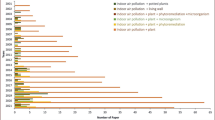Abstract
This paper sets up an analytic model of double surface emission of volatile organic compound (VOC) from dry, flat-plate building materials. Based on it, the influence of factors including air change rate, loading factor of materials in the room, mass diffusion coefficient, partition coefficient, convective mass transfer coefficient, thickness of materials, asymmetric convective flow and initial VOC concentration distribution in the building material on emission is discussed. The conditions for simplifying double surface emission into single surface emission are also discussed. The model is helpful to assess the double surface VOC emission from flat-plate building materials used in indoor fumiture and space partition.
Similar content being viewed by others
References
Klepeis N E, Nelson W C, Off W R, et al. The national human active pattern survey (NHAPS): A resource for assessing exposure to environmental pollutions. Journal of Exposure Analysis and Environmental Epidemiology, 2001, 11: 231–252
Kim Y M, Harrad S, Harrison R M. Concentrations and sources of VOCs in urban domestic and public microenvironments. Environmental Science & Technology, 2001, 35: 997–1004
Meininghaus R, Salthammer T, et al. Interaction of volatile organic compounds with indoor materials: A small-scale screening method. Atmospheric Environment, 1999, 33: 2395–2401
Molhave L. The sick buildings and other buildings with indoor climate problems. Environment, 1989, 15: 65–74
U.S. EPA, Reducing Risk: Setting Priorities and Strategies for Environmental Peducing. Science Advisory Board, U.S. Environmental Protection Agency, Washington, DC, 1990
World Health Organization, Indoor Air Quality: Organic Pollutants, Copenhagen: WHO Regional Office for Europe (EURO Report and Studies IIII), 1989
Yu C, Crump D. A review of the emission of VOCs from polymeric materials used in buildings. Building and Environment, 1998, 22: 357–374
Matthews T G, Hawthorne A R, Thompson C V. Formaldehyde sorption and desorption characteristics of gypsum wallboard. Environmental Science & Technology, 1987, 21: 629–634
Colombo A, De Bortolli M, Pecchio E, et al. Chamber testing of organic emissions from building and furnishing materials. Science of the Total Environment, 1987, 91: 237–249
Clausen P A, Laursen B, Wolkoff P, et al. Emission of volatile organic compounds from vinyl floor covering. In: Nagda N L, ed. Modeling of Indoor Air Quality and Exposure ASTM STP1205. Philadelphia: American Society of Testing and Materials, 1993, 3–13
Zhu J P, Zhang J S, Shaw C Y. Comparison of models for describing measured VOC emissions from wood-based panels under dynamic chamber test condition. Chemosphere, 2001, 44: 1253–1257
Zhao D, Little J C, Hodgson A T. Modeling the reversible, diffusive sink effect in response to transient contaminant sources. Indoor Air, 2002, 12: 184–190
Little J C, Hodgson A T, Gadgil A J, Modeling emissions of volatile organic compounds from new carpets. Atmospheric Environment, 1994, 28(2): 227–234
Xu Y, Zhang Y P. An improved mass transfer based model for analyzing VOC emissions from building materials. Atmospheric Environment, 2003, 37(18): 2497–2505
Huang H, Haghighat F. Modeling of VOC emission from dry building materials. Building and Environment, 2002, 37: 1349–1360
Lee C S, Haghighat F, Ghaly W S. A study on VOC source and sink behavior in porous building materials—Analytical model development and assessment. Indoor Air, 2005, 15: 183–196
Li F, Niu J L. Numerical simulation of VOCs emissions from multi-layer porous/non-porous building material assemblies. In: Proceedings of International Conference of Indoor Air Quality and Climate, Beijing, 2005. 2707–2712
Ozisik M N. Heat Conduction. New York: Wiley, 1980
Yang X. Study of building materials emissions and indoor air quality. Ph.D. Thesis of Massachusetts Institute of Technology, 1999
Xu Y, Zhang Y P. A general model for analyzing VOC emission characteristics from building materials and its application. Atmospheric Environment, 2004, 38(1): 113–119
Author information
Authors and Affiliations
Corresponding author
About this article
Cite this article
Wang, X., Zhang, Y. & Zhao, R. Study on characteristics of double surface VOC emissions from dry flat-plate building materials. CHINESE SCI BULL 51, 2287–2293 (2006). https://doi.org/10.1007/s11434-006-2110-4
Received:
Accepted:
Issue Date:
DOI: https://doi.org/10.1007/s11434-006-2110-4




